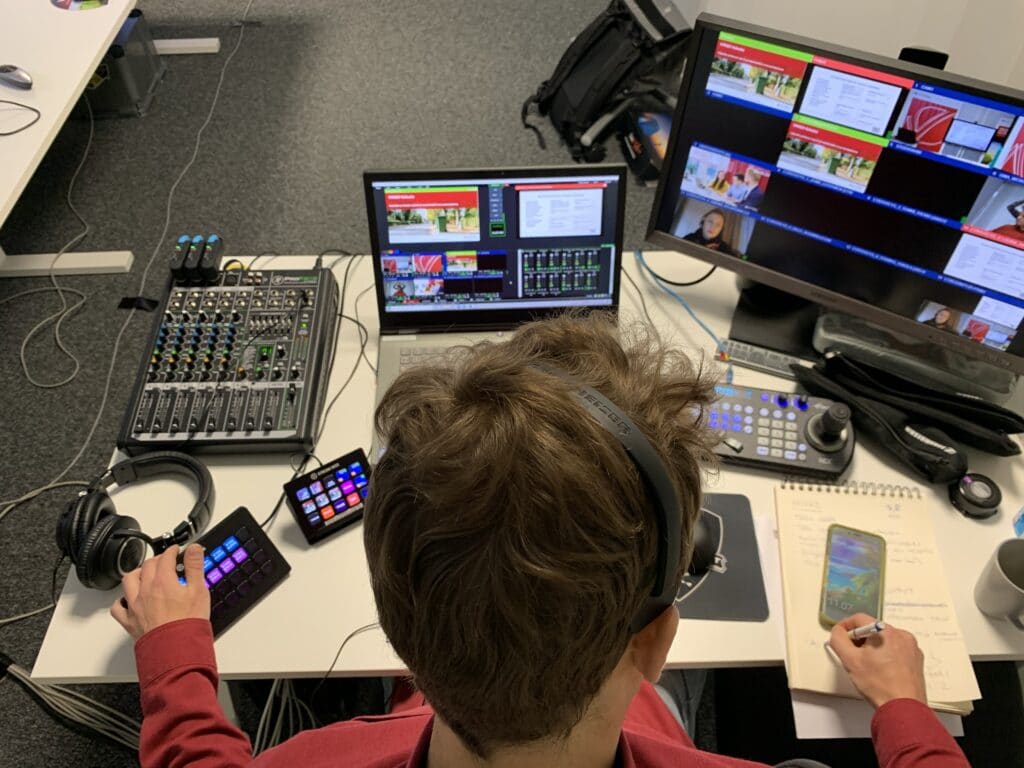Mikäli webinaari toteutetaan webinaarilähetyksenä, on yleensä kyseessä fyysinen tapahtuma, joka suoratoistetaan nettiin reaaliaikaisena lähetyksenä. Tällöin tapahtuman esiintyjä puhuu paikalla olevalle yleisölle, ja webinaarilähetyksen katsojat, eli etäosallistujat, toimivat ikään kuin sekundaarisena yleisönä. Mikäli webinaarilähetys tallennetaan myöhempää käyttöä varten, ovat tallenteen katsojat käytännössä lähetyksen kolmas yleisö. Webinaarilähetyksiä hyödynnetään etenkin koulutus- ja opetustilaisuuksiin, sillä niiden avulla on mahdollista tavoittaa jopa satoja osallistujia samanaikaisesti. Virtuaalisia tapahtumia järjestetään puolestaan pienemmille ryhmille, ja ne soveltuvat mainiosti esimerkiksi kokousten, oppituntien ja kurssien järjestämiseen. Webinaariohjelmia löytyy netistä useita, ja jotkut niistä ovat jopa ilmaisia. Kuitenkin maksullistenkin ohjelmien käyttö on tavallisesti vain järjestäjälle maksullista, mutta osallistujille maksutonta.
Webinaareja voidaan hyödyntää muun muassa etäopetukseen, luentojen pitämiseen, markkinointiin, tiedotukseen ja tuotelanseerauksiin, ja ne voidaan toteuttaa kahdesta erilaisesta lähtökohdasta: virtuaalitapahtumana tai webinaarilähetyksenä. Lähtökohtaisesti kuitenkin webinaari on aina virtuaalinen tapahtuma, jossa kaikki osanottajat osallistuvat tapahtumaan omalta laitteeltaan maantieteellisestä sijainnistaan riippumatta. Tällöin kaikkien osallistujien näytöllä näkyy yleensä sama näkymä, kuten esimerkiksi esiintyjän kasvot, PowerPoint-esitys, dioja tai edellä mainittujen yhdistelmiä. Webinaareissa on myös mahdollisuus keskustella ja esittää kysymyksiä, ja tilaisuuksissa tarjoutuu niin ikään oiva mahdollisuus erilaisten äänestysten järjestämiseen.
Webinaareista on hyötyä sekä järjestäjille että osallistujille, sillä ne säästävät sekä rahaa että aikaa. Osallistuminen on helppoa, sillä sitä varten ei tarvitse kuin vakaan internet-yhteyden. Äänentoistoon riittää tavallisesti kuulokkeet. Kun esimerkiksi luento tai kurssi on mahdollista järjestää etänä, säästytään ylimääräisiltä tilavuokrilta ja matkustuskuluilta. Mahdolliset osallistumiskulut voidaan pitää pienenä, ja tilaisuuden pitäjälle jää tuloista enemmän voittoa. Webinaarin avulla voidaan tavoittaa moninkertainen yleisö fyysiseen tilaisuuteen verrattuna, sillä virtuaalitapahtumiin voi osallistua jopa toisesta valtiosta.
Webinaareihin on mahdollista osallistua missä ja milloin vain, joten fyysisiin tilaisuuksiin verrattuna verkkoseminaareista karsiutuvat pois niin tapahtumapaikalle siirtyminen, tilaisuuden alun odottaminen kuin kotimatkakin, joten parhaimmassa tapauksessa nettitapahtuma säästää aikaa jopa useita tunteja. Webinaarien etuna on myös joustavuus ja jouhevuus, sillä kun fyysisten tilaisuuksien järjestäminen vaatii runsaasti aikaa ja järjestelyjä, voidaan webinaari pystyttää tarpeen tullen nopeasti. Tästä syystä webinaari soveltuu mainiosti myös muun muassa kriisiviestinnän kanavaksi. Tänä maailmanaikana ihmisten arvoissa korostuu myös ennen kaikkea ekologisuus, ja siitäkin syystä webinaari on oiva vaihtoehto fyysisille tapahtumille – webinaarin toteuttamiseen kuluva energiamäärä jää minimaaliseksi verrattuna kaikkien osanottajien tapahtumapaikalle siirtymisestä aiheutuvaan energiankulutukseen.
Webinaarien järjestäminen on helppoa, mutta eri toimintojen oppiminen voi vaatia aloittelijoilta harjoittelua. Hyvässä webinaarissa tekniikka toimii ja puhe soljuu. Yleisin haaste järjestäjälle on erilaiset tekniset ongelmat, jolloin esimerkiksi internet-yhteys katkeaa, chat-toiminto lakkaa toimimasta tai näytön jakaminen ei onnistu. Paras tapa välttyä tällaisilta ongelmilta onkin kokeilla laitteiden toimivuus hyvissä ajoin ennen webinaarin alkamista. Solid Streamilla on kehitetty toimivat ratkaisut esiintyjän työtä helpottamaan. Haasteita webinaarin aikana voi tuoda myös esimerkiksi esityksen epäjohdonmukaisuus tai hiljaiset hetket, ja tästä syystä esitys kannattaisikin harjoitella perinpohjaisesti läpi ennen seminaaria. Webinaareissa korostuu ennen kaikkea laadukkaan ja kiinnostavan sisällön tuottamisen tärkeys, sillä kun osallistujat ovat eri tilassa esiintyjän kanssa, tuo se haasteita myös katselijoiden keskittymiskyvyn ylläpitämiseen.









